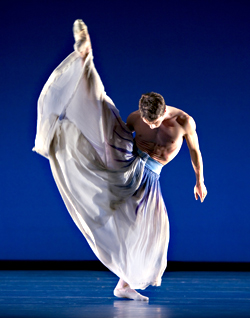Since his arrival at Pacific Northwest Ballet, new artistic director Peter Boal has been tweaking some things, but this month’s Celebrate Seattle Festival represents not just readjustment but radical change. Over the three weeks of the festival, PNB will perform or present pieces by 14 different choreographers—as many dances as the company traditionally does over the whole season. There will also be lectures and “meet the artist” sessions. If you want to see everything they’ve got scheduled, you’ll need to pitch a tent in the lobby of McCaw Hall.
The organizing theme is choreographers from the Northwest, which is broad enough to include the radical as well as the mainstream. There isn’t a single aesthetic or style in the collection, or a single career path—some of the artists represented have made their mark in the Northwest, while others were here only for a short while.
The first piece being performed is one of the most exciting: Mark Morris’ Pacific. First performed by the San Francisco Ballet, this is modern dance for ballet dancers. The wide stance and powerful vocabulary are more reminiscent of Martha Graham or the German expressionist Kurt Jooss, especially for the women. Morris is known for subverting traditional gender roles and continues that style here, as the men bound into the air and the women stalk through the space. You can certainly read water images into the dance, but the real pacific elements are the felicitous use of the musical score and the faithful performance given by the PNB dancers.
For the first two weeks of the festival, Pacific is paired with Kent Stowell’s staging of Carmina Burana, a big, boisterous piece that uses nearly every dancer in the company, filling the stage with color and movement. Between the dancers, the chorus, and Ming Cho Lee’s set, with its enormous, golden “Wheel of Fate” hanging overhead, our eyes are overwhelmed even before the piece begins. The company has performed the piece several times since its 1993 premiere, and there are a few interesting debuts here. Carla Körbes brings her rich sense of detail to the role of the Harlot, showing every physical initiation and decision that goes into making long movement phrases. Jordan Pacitti, returning after an injury, makes a suitably frightening priest, flagellating himself in the tavern scene, while both sets of couples in the country dances (Kaori Nakamura and Le Yin, and Noelani Pantastico and Jeffrey Stanton) are charming lads and lasses.
The third week of the festival will present three different programs in rotation. Program A features new stagings of work by Merce Cunningham (his watery Inlets 2) and Robert Joffrey (the duet from Remembrances, which was first created for another Northwest native, Francesca Corkle, and includes renowned soprano Jane Eaglen), the revival of Val Caniparoli’s stylish Torque, and a new piece by PNB dancer Kiyon Gaines. Program B includes guest performers from Ballet British Columbia (in artistic director John Alleyne’s Schubert) and Spectrum Dance Theater (performing Donald Byrd’s Bhangra Fever), alongside PNB dancers in Ripple Mechanics, by modern choreographer Sonia Dawkins, and Two’s Company, by Eugene Ballet’s Toni Pimble. The third program features guests from Oregon Ballet Theatre in Christopher Stowell’s Adin, to a score by Rachmaninoff, and local ensemble Scott/Powell Performance in Locate, a work by director Mary Sheldon Scott. PNB dancers perform in a premier from PNB ballet master Paul Gibson and in three works by the ever-tricky Trisha Brown, including her groundbreaking Spanish Dance, which was a herald of postmodern choreography.
Many of the choreographers or stagers will be participating in postshow question-and-answer sessions or public interviews; there are performances from the small-is-beautiful project Ten Tiny Dances in the lobby during intermissions; and there is a series of program dedications to artists and activists who have continued to support dance in the Northwest.








